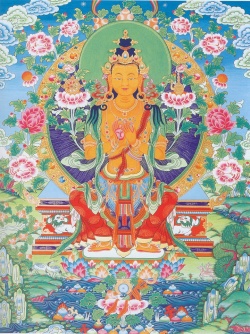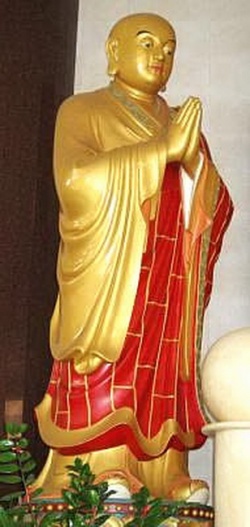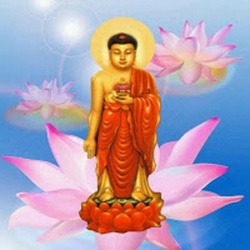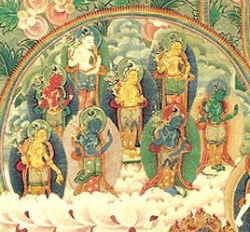Bodhisattva Precepts
The Bodhisattva Precepts (Chinese: 菩薩戒; pinyin: púsà jiè, Japanese: bosatsukai) are a set of moral codes used in Mahayana Buddhism to advance a practitioner along the path to becoming a Bodhisattva. Traditionally, monastics observed the basic moral code in Buddhism, the Pratimoksha, but in the Mahayana tradition, monks would additionally observe the Bodhisattva Precepts on top of the existing code. Bodhisattva Precepts: The Bodhisattva Precepts are 58 in number and are listed and explained in the Brahma Net Sutra.
bodhisattva precepts (byang sdom). According to the system of Nagarjuna, the Chariot of the Profound View, the precepts are to refrain from the following: to steal the funds of the Three Jewels; to commit the act of forsaking the Dharma; to punish or cause to lose the precepts etc. people who possess or have lapsed from the trainings; to commit the five acts with immediate result; to violate the five definite precepts for a king, such as keeping wrong views and so forth; to violate the five definitive precepts for a minister such as destroying a village, a valley, a city, a district, or a country; to give premature teachings on emptiness to people who haven't trained in the Mahayana; to aspire towards the shravakas of the Hinayana after having reached the Mahayana;
to train in the Mahayana after forsaking the Individual Liberation; to disparage the Hinayana; to praise oneself and disparage others; to be highly hypocritical for the sake of honor and gain; to let a monk receive punishment and be humiliated; to harm others by bribing a king or a minister in order to punish them; to give the food of a renunciant meditator to a reciter of scriptures and thus causing obstacles for the cultivation of shamatha.
The eighty subsidiary infractions are to forsake the happiness of ' another being and so forth.
According to the system of Asanga, the Chariot of the Vast Conduct, the precepts for the bodhichitta of aspiration are as follows: to never forsake sentient beings, to remember the benefits of bodhichitta, to gather the accumulations, to exert oneself in training in bodhichitta, as well as to adopt and avoid the eight black and white deeds.
The four precepts for the bodhichitta of application are (to avoid the following):
1) out of desire, to have exceeding attachment to honor and gain and to praise oneself and disparage others, 2) out of stinginess, to refrain from giving material things, Dharma teachings and wealth to others, 3) out of anger, to harm others and be unforgiving when offered an apology, 4) out of stupidity, to pretend that indolence is Dharma and to teach that to others.
The 46 minor infractions are to refrain from making offerings to the Three Jewels and so forth. The four black deeds are to deceive a venerable person, to cause someone to regret what is not regrettable, to disparage a sublime person, and to deceive sentient beings. The four white are their opposites.
Alternatively, the Bodhisattva Precepts are often called the "Brahma Net Precepts" (Chinese: 梵網戒; pinyin: Fànwǎng jiè; Wade–Giles: Fan wang jie), particularly in Buddhist scholarship.
Origin
The Precepts are derived from Mahayana version of the Brahma Net Sutra, which lists out 10 Major Precepts and 48 Minor Precepts a monk is expected to follow. Typically, in many traditions, only the 10 Major Precepts are considered the Bodhisattva Precepts.
According to the sutra, the 10 Major Bodhisattva Precepts are in summary:
- Not to kill or encourage others to kill.
- Not to steal or encourage others to steal.
- Not to engage in licentious acts or encourage others to do so. A monk is expected to abstain from sexual conduct entirely.
- Not to use false words and speech, or encourage others to do so.
- Not to trade or sell alcoholic beverages or encourage others to do so.
- Not to broadcast the misdeeds or faults of the Buddhist assembly, nor encourage others to do so.
- Not to praise oneself and speak ill of others, or encourage others to do so.
- Not to be stingy, or encourage others to do so.
- Not to harbor anger or encourage others to be angry.
- Not to speak ill of the Buddha, the Dharma or the Sangha (lit. the Triple Jewel)) or encourage others to do so.
Breaking any of these precepts is described as a major (lit. Parajika) offense in the sutra.
In Practice
Chinese Chan Buddhist monk, Yin Shun wrote of the Bodhisattva Precepts:
- To cultivate bodhi mind means to accept the bodhisattva precepts and practice the ten good deeds.
In practice, the acceptance of and ordination of the Bodhisattva Precepts varies greatly depending on the Mahayana Buddhist sect. In traditional Mahayana monastic communities in East Asia, a fully ordained monk or nun ordains under the traditional Prātimokṣa precepts first, as described in the Dharmaguptakavinaya. In Chinese ordination, this was referred to as the "Vinaya in Four Parts" ((Chinese: 四分律; pinyin: Shìfēnlǜ; Wade–Giles: Ssŭ-fen lü). Then as a supplement, the same disciple would undertake the Bodhisattva Precepts as well. A monk was not considered "ordained" through by the Bodhisattva Precepts, but rather by the ordaining under the Four Part Vinaya, while the Bodhisattva Precepts served to strengthen the Mahayana ideals.
Similarly, the Bodhisattva Precepts were given to lay disciples to strengthen their devotion to Buddhism as well. Such disciples often take the basic five precepts and then the Bodhisattva precepts as a supplement.
Japanese ordination
In Japanese Buddhism, with the rise of Saicho and the Tendai sect, the original Vinaya lineage was de-emphasized, and a new monastic community was set up using the Bodhisattva Precepts exclusively. All Vinaya ordinations at the time were given at Todaiji temple in Nara Japan, and Saicho had wanted to both undermine the power of the Nara Buddhist community, and establish a "purely Mahayana lineage", and made a request to the Emperor to Later Buddhist sects, which was granted 7 days after his death in 822.
Later Buddhist sects in Japan, including Soto Zen, Shingon and Jodo Shu adopted a similar approach to their monastic communities, and exclusive use of the Bodhisattva Precepts. By this time in Japan, the Vinaya lineage had all but died out and Japan's remote location made it difficult to re-establish though limited efforts by Jokei and the Shingon Risshū sect revived it for a time. This was further enforced during the Meiji Period when the Nikujiku Saitai Law (肉食妻帯) of 1872 forbid monks to be celibate or abstain from eating meat.
The Sixteen Bodhisattva Precepts in Soto Zen
In Soto Zen, the founder Dogen established a somewhat expanded version of the Bodhisattva Precepts for use by both priests and lay followers, based on both Brahma Net Sutra and other sources. Many various translations exist, the following is used by John Daido Loori, Roshi at the Zen Mountain Monastery:
The Three Treasures
The Three Treasures are universally known in Buddhism as the Three Refuges or Three Jewels.
The Three Pure Precepts
- Do not create Evil
- Practice Good
- Actualize Good For Others
These are also known as the Three Root Precepts, and are mentioned in the Brahma Net Sutra as well.
The Ten Grave Precepts
- Affirm life – Do not kill
- Be giving – Do not steal
- Honor the body – Do not misuse sexuality
- Manifest truth – Do not lie
- Proceed clearly – Do not cloud the mind
- See the perfection – Do not speak of others errors and faults
- Realize self and other as one – Do not elevate the self and blame others
- Give generously – Do not be withholding
- Actualize harmony – Do not be angry
- Experience the intimacy of things – Do not defile the Three Treasures



